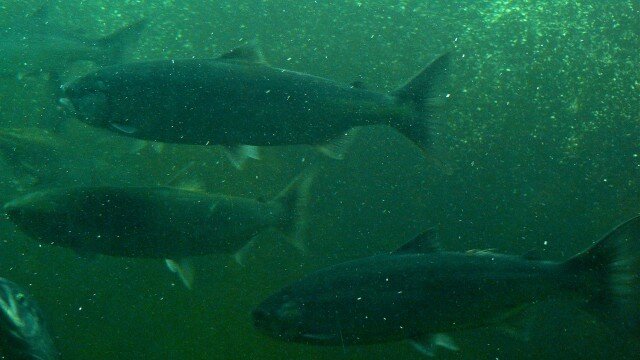
The lethal and highly infectious salmon anemia virus (ISAV) has, it’s been reported by the New York Times, “detected for the first time in wild salmon in the Pacific Northwest.” The virulent form causes damage to blood vessels and blood cells–sick fish have pale gills and hemorrhage internally.
Of 48 juvenile sockeye salmon taken from British Columbia’s River Inlet, two tested positive for ISAV. Those findings are being checked now by third parties, but the original was performed by Dr. Fred Kibenge, from the OIE reference lab for ISAV. (Kibenge’s name is on most every ISAV study you will come across.)
Simon Fraser University’s Richard Routledge, a lead author on the study with biologist Alexandra Morton, is quoted as saying the virus might have “a devastating impact” on wild and farmed salmon. To date the virus has had its most lethal results in the hot zones created by salmon farms. Specifically, salmon farms raising Atlantic salmon.
A 2006 study found, “Coho salmon were resistant to all ISAV isolates”–Pacific salmon could carry the virus, but would not display symptoms. They were a disease reservoir. (This despite a 2001 study that found Chilean farmed Coho were killed by ISAV.) That’s why this finding, in a mysteriously declining population of Pacific salmon, is so disturbing.
Nor is the activist Morton disinterested, as her blog makes clear:
…Canada has failed to maintain a line of defense against ISAV. There is no place on the Fish Health Certificate that must be signed by foreign hatcheries to report ISAV. Even when the European strain of the virus began spreading in Chile, Canada did not close the border to eggs, government did not even make it a reportable disease if it occurred on a fish farm, even though it is an internationally reportable disease.
Classified as an Orthomyxoviridae virus, ISAV’s “behavior” is compared analogically to influenza, while researchers attempt to find out how, specifically, the virus works: “Through functional studies of the coded proteins it has been established that RNA segments 5 and 6 code for a fusion protein and hemagglutinin, respectively, while two polypeptides coded by segments 7 and 8 inhibit interferon induction.”Ah.
It’s definitely a fish flu, and not something you can pick from a can of salmon mousse (unless you are an Atlantic salmon), but of course influenza-type viruses tend to mutate. When scientists examined the 2007 strain of ISAV that decimated Chilean salmon farms, they discovered that the strain had arrived in Chile about 1996. The 2007 incidence of ISAV “caused the overall production of salmon to plummet 50% and 15,000 employees to lose their jobs.”
(ISAV is not the only disease stalking salmon, of course: “Severe infection by the myxozoan parasite Ceratomyxa shasta has, in large part, been responsible for the declining numbers of juvenile K[lamath] R[iver] fall Chinook and coho salmon and subsequent impacts on later adult returns.“)
U.S. Senators Maria Cantwell (D-WA), Lisa Murkowski (R-AK), and Mark Begich (D-AK) are taking no chances on it being ISAV. The three are calling for an investigation of the potential spread of the virus: Commerce, Justice, Science (CJS) Appropriations bill (H.R. 2112), “calls on the National Aquatic Animal Health Task Force to evaluate the risk the virus could have on salmon off West Coast waters and Alaskan waters, and to develop a plan to address this emerging threat,” says a release from Cantwell’s office.
